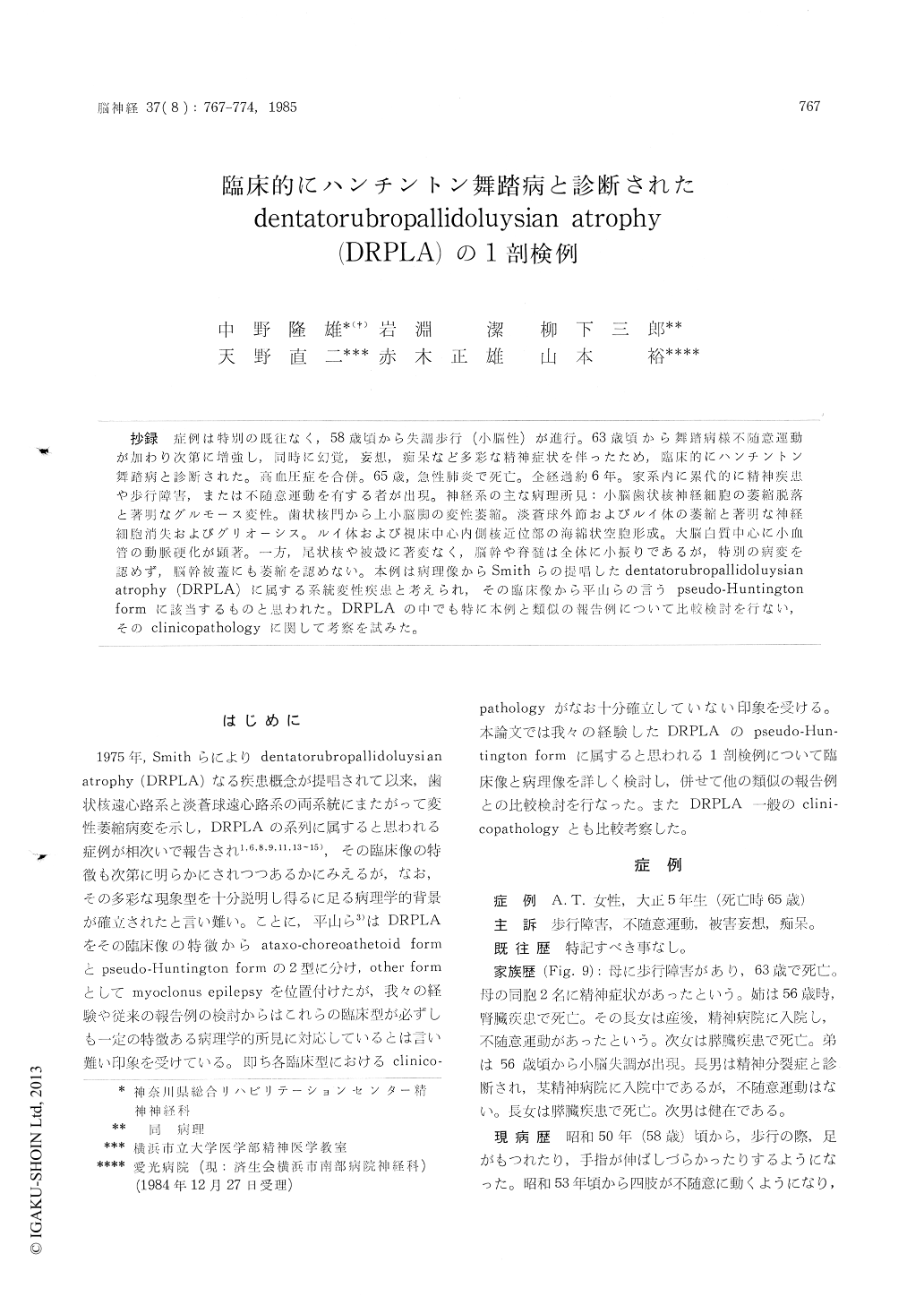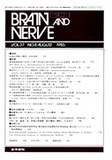Japanese
English
- 有料閲覧
- Abstract 文献概要
- 1ページ目 Look Inside
抄録 症例は特別の既往なく,58歳頃から失調歩行(小脳性)が進行。63歳頃から舞踏病様不随意運動が加わり次第に増強し,同時に幻覚,妄想,痴呆など多彩な精神症状を伴ったため,臨床的にハンチントン舞踏病と診断された。高血圧症を合併。65歳,急性肺炎で死亡。全経過約6年。家系内に累代的に精神疾患や歩行障害,または不随意運動を有する者が出現。神経系の主な病理所見:小脳歯状核神経細胞の萎縮脱落と著明なグルモース変性。歯状核門から上小脳脚の変性萎縮。淡蒼球外節およびルイ体の萎縮と著明な神経細胞消失およびグリオーシス。ルイ体および視床中心内側核近位部の海綿状空胞形成。大脳白質中心に小血管の動脈硬化が顕著。一方,尾状核や被殻に著変なく,脳幹や脊髄は全体に小振りであるが,特別の病変を認めず,脳幹被蓋にも萎縮を認めない。本例は病理像からSmithらの提唱したdentatorubropallidoluysianatrophy (DRPLA)に属する系統変性疾患と考えられ,その臨床像から平山らの言うpseudo-Huntington formに該当するものと思われた。DRPLAの中でも特に本例と類似の報告例について比較検討を行ない,そのclinicopathologyに関して考察を試みた。
An autopsy case of a 65-year-old female with dentatorubropallidoluysian atrophy (DRPLA) is reported. Her mother had gait disturbance and died at the age of 63. Her mother's brother developed psychotic symptoms. A daughter of her older sister was observed to have involuntary movement when she admitted to a mental hospital due to post-delivery psychotic state. Her younger brother has developed gait disturbance from about 56-year-old. Her older son has suffered from schizophrenia for long years.
Since 58-year-old, she developed cerebellar ata-xic gait and three years later, choreic involuntary movement developed in her extremities and face and progressively became prominent. Since 63-year-old, abnormal behavior brought about by the visual hallucination was occasionally observed. At the age of 63, she admitted to a mental hospital because of persistent persecutive delusion for her husband and was clinically diagnosed as Huntington's chorea for her remarkable choreic movement and psychotic state with dementia. Hypertension was also noticed. At the age of 65, she died of acute pneumonia. The duration of her illness was about 6 years.
Histopathological findings of the CNS : the brain weighed 1, 014 g. Brainstem and spinal cord were noticed to be relatively small in size. The cerebral cortex was well preserved. The cerebral white matter was diffusely demyelinated in the central semiovale where arteriosclerotic change of the small vessels was remarkable. Significant pa-thological changes consisted of marked symmetrical atrophy of the following two systems, i. e., denta-tofugal pallidoluysian systems.
Neurons of the dentate nucleus were moderately diminished in number and remaining ones showed noticeable grumose degenerations. From its hilus to the superior cerebellar peduncle, marked fibrous gliosis developed. The external segment of the globus pallidus was severely atrophic with mar-ked loss of neurons and glial proliferation. Sub-thalamic nucleus (Luy) was also atrophic and also remarkably spongy. In and around the centrome-dian nucleus of thalamus, neuronal loss and spongy state was also observed. Any pathological change could not be observed in the caudate nucleus and putamen except for a small infarction in the puta-men.
Any specific pathological change could not de-tect in the brainstem and spinal cord although these structures were entirely small in size. The tegmentum of the midbrain and pons were wellpreserved. Nucleus basalis of Meynert and nucleusaccumbens were almost intact.
From the clinicopathological findings, the presentcase was considered to be compatible with pseudo-Huntington form of DRPLA proposed by Hira-yama et al.Clinicopathology of the pseudo-Hun-tington form of DRPLA was discussed.

Copyright © 1985, Igaku-Shoin Ltd. All rights reserved.


